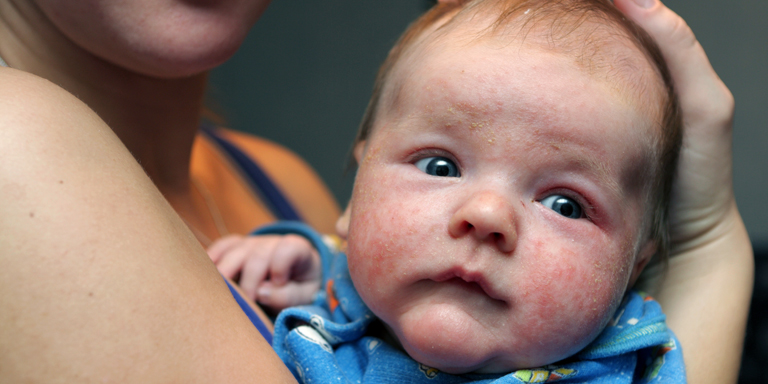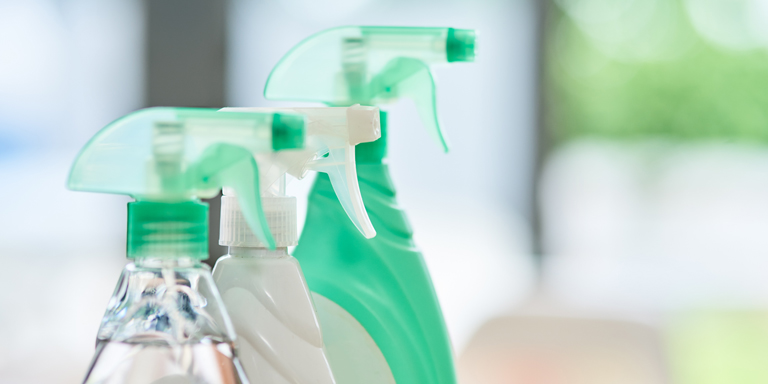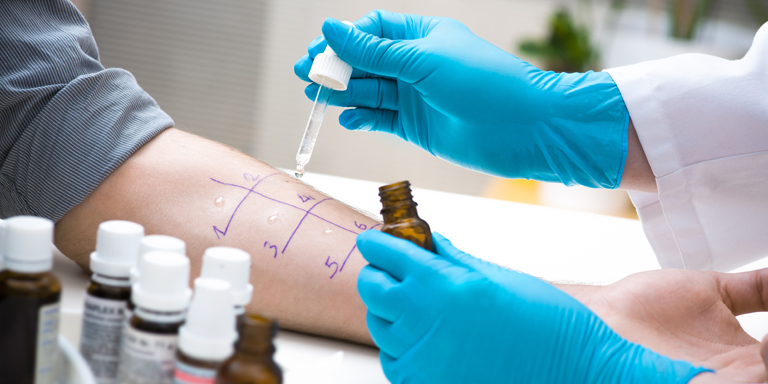Atopic dermatitis (atopic eczema, neurodermatitis)
Atopic dermatitis/eczema or neurodermatitis is a chronic skin disease that typically first manifests in infancy.

Table of contents:
A hereditary predisposition is the underlying cause of the skin disease and in 85% of cases the disease manifests in the first five years of life. In atopic dermatitis, the skin’s condition constantly changes and symptoms can appear simultaneously or in varying degrees.
Causes
The causes of atopic dermatitis are many and varied. Genetic predisposition, environmental factors as well as inflammation taking place in the skin are all involved.
A deficiency, imbalance or defective functioning of substances (e.g. proteins or fats) responsible for the formation of the upper layer of the skin leads to a reduced skin barrier function, resulting in more water evaporating and the skin becoming dry. The skin also becomes more permeable to allergens and other environmental substances. These can trigger inflammatory reactions.
As well as the changes to the structure of the skin, factors such as climate / weather, psychological stress and chemical irritants (e.g. shower and washing products) also affect skin condition. The triggers for an episode of atopic dermatitis differ from one person to the next and can change during the course of a lifetime. Frequently, more than one factor is involved, which is why it is often difficult to identify the trigger or triggers.
Symptoms
In atopic dermatitis the skin’s condition constantly changes. The following symptoms may occur:
- dry, sensitive skin
- itching
- redness
- scaly skin
- weeping patches of skin
- crust formation
- rough skin with raised surface
- formation of nodules
These symptoms can appear simultaneously or in varying degrees. The eczema appears on typical areas of skin, depending on the sufferer’s age. During infancy it mainly affects the face, the upper body, hands and extensor surfaces of the arms and legs. In small children, the episodes mainly occur in the hollows of the knees, elbows, on the face, neck and throat. Hand and foot eczema may additionally be observed in older children, adolescents and adults.
Diagnosis
There is no laboratory test to establish atopic dermatitis. The diagnosis is based on the typical symptoms listed above. This requires a thorough discussion between the doctor and the parents or the sufferer as well as examination of the skin. Atopic illnesses in the family can be an important indicator.
Skin diseases such as psoriasis can sometimes cause similar symptoms. Detailed investigations with a dermatologist can provide the necessary information.
Treatment
Basic care is the foundation of treatment for atopic dermatitis. It involves cleansing the skin and skin care. This can prevent infections while suitable care products supply the skin with fat and moisture. Unfortunately, there is no general all-in-one product for all sufferers.
The choice of care product should be adapted to the seasons:
- In winter, when the air is cold and dry, select products with a higher fat content.
- In summer, when the air is hot and damp, products with a low fat content but a higher moisture content feel comfortable.
If the condition of the skin deteriorates despite good basic care, anti-inflammatory therapy is often necessary as an additional measure.
Cortisone creams and ointments and calcineurin inhibitors / immunomodulators are available for this purpose.
New drugs have now been developed that contain immunomodulators (antibodies). For the time being, these products are used in young people and adults with severe and treatment-refractory eczema.
Biological drugs are produced from living organisms or cells and are injected at intervals of several weeks. Biomedicines can have a targeted influence on various players in our body, for example by neutralising substances that transmit inflammation signals or by attacking certain inflammatory cells. At present, biomedicines are used as an adjunct to existing treatments, and only when the clinical picture is severe and standard treatment is not sufficient. This treatment may have side effects that should be discussed with the treating physician.
Janus kinase inhibitors, or JAK inhibitors, are produced synthetically and are taken in tablet form once or twice a day. They inhibit the formation of pro-inflammatory messenger substances, thereby reducing eczema. Janus kinase inhibitors are used when treatment with conventional disease-modifying drugs, such as cortisone creams, is not sufficient. This treatment may also have side effects that should be discussed with the doctor.
Many sufferers experience severe itching. Scratching will temporarily get rid of the itching but it damages the skin, which in turn encourages itching. The most important measure against itching is to treat the eczema. The following can also alleviate itching: wearing cooling, skin-friendly and breathable fabrics; using compresses and dressings with black tea, table salt or ointments.
Tips and tricks
- As sweating makes itching worse, it helps not to have too many bed covers on at night and, during the day, to wear clothing appropriate to the temperature.
- Wear the innermost layer of clothing with the seams outwards to prevent them from irritating the skin.
- Instead of fabric softener, use small amounts of vinegar.
- Relaxation techniques (e.g. yoga, progressive muscle relaxation, autogenic training) can help people deal with psychological stress.
- When shopping, look out for products with the Allergy Seal of Quality, these are particularly suitable for people with allergies and intolerances and are recommended by aha! Swiss Allergy Centre.
Facts and figures
Around 20% of children in Switzerland are affected by atopic dermatitis. The rate in adults is thought to be 4–5%. The symptoms appear in the first five years of life in 85% of cases.
Editors: aha! Swiss Allergy Centre in co-operation with the Scientific Advisory Board.




